Through our ‘How to Green Lab’ monthly series, we share useful tips and hacks to help make your lab more sustainable!
Follow us on Twitter & LinkedIn to receive a #HowToGreenLab tip every month!
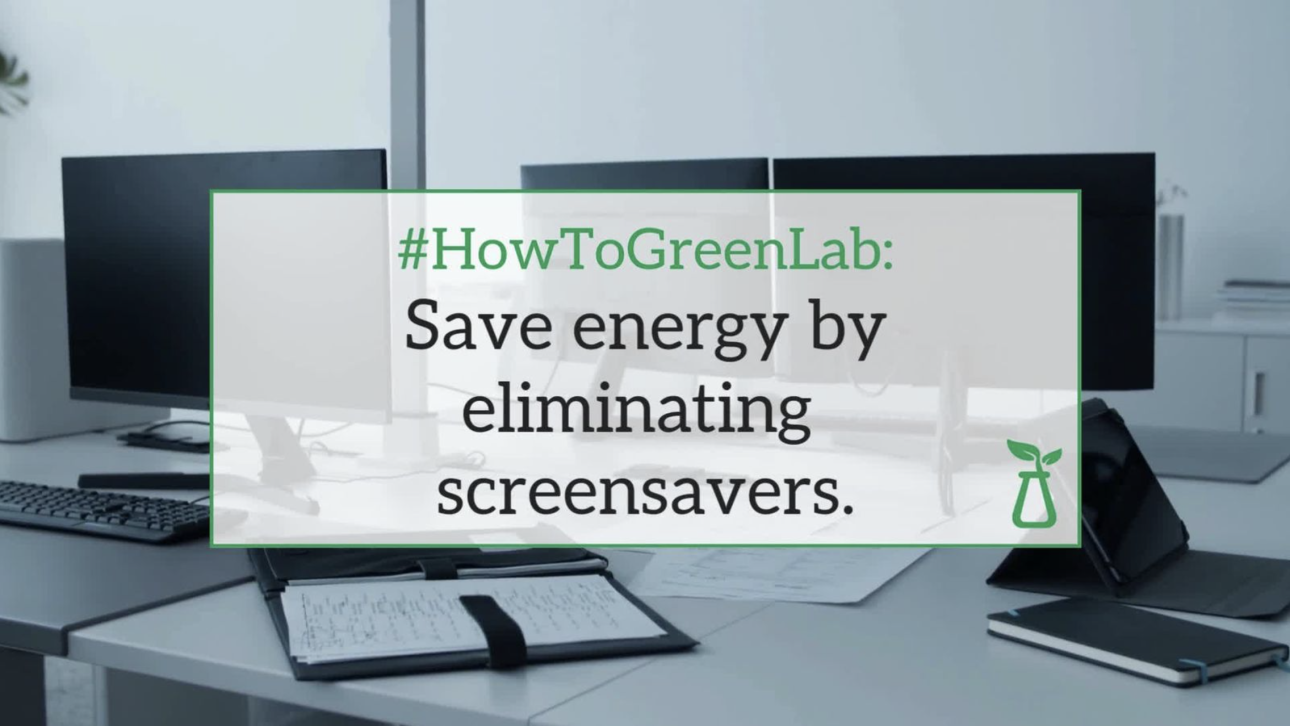
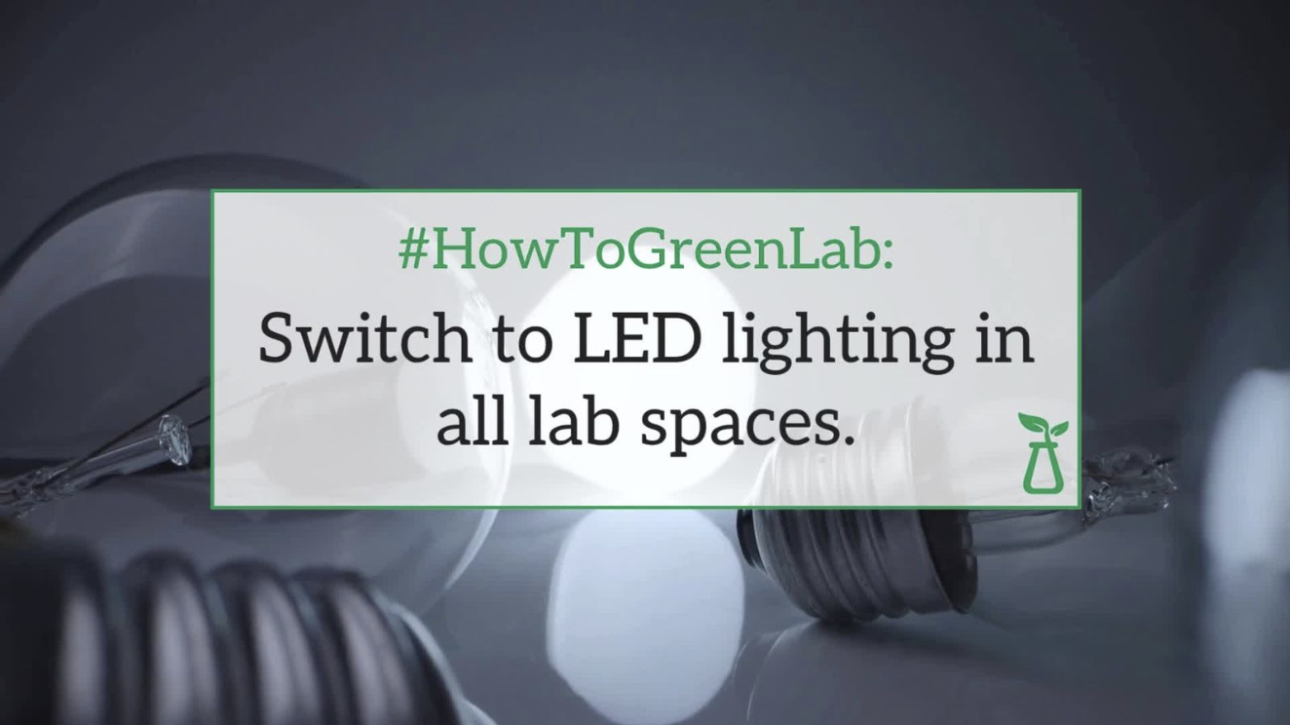
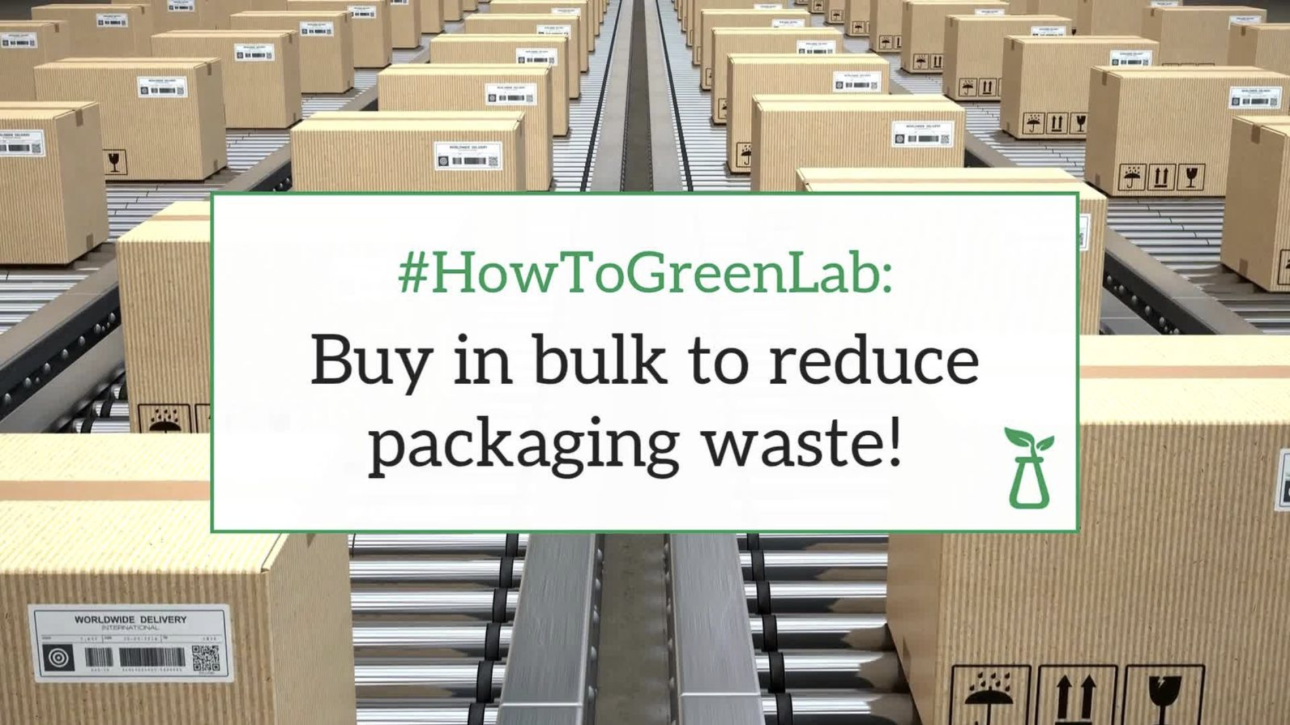
This month’s #HowToGreenLab is to find lab products with lower environmental impact through the ACT Ecolabel database!
Designed for scientists and procurement pros, this searchable tool gives you clear, third-party verified info on the environmental impact of lab products so you can make smarter choices without the guesswork.
With a recent upgrade to the ACT Ecolabel program, products in the database undergo a science-based, third-party reviewed framework for assessing and communicating the environmental impact of laboratory products.
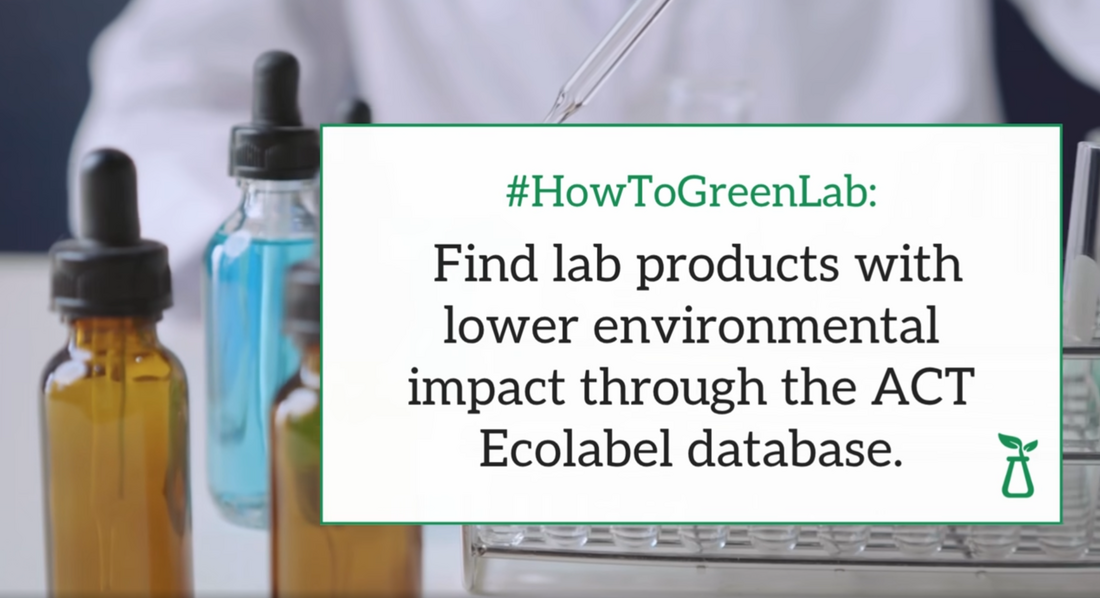
Don’t let water sources run when they don’t need to be running!
If you’re washing glassware or filling up your flasks with water, a common practice may be to walk away while the faucet is running. This can lead to unnecessary overflow. Instead, always keep your eyes on a running water source.
Alternatively, consider a timed water valve that runs for a certain amount of time or only discharges a certain amount of water. Or, install foot petals so you’re only pumping water when needed.
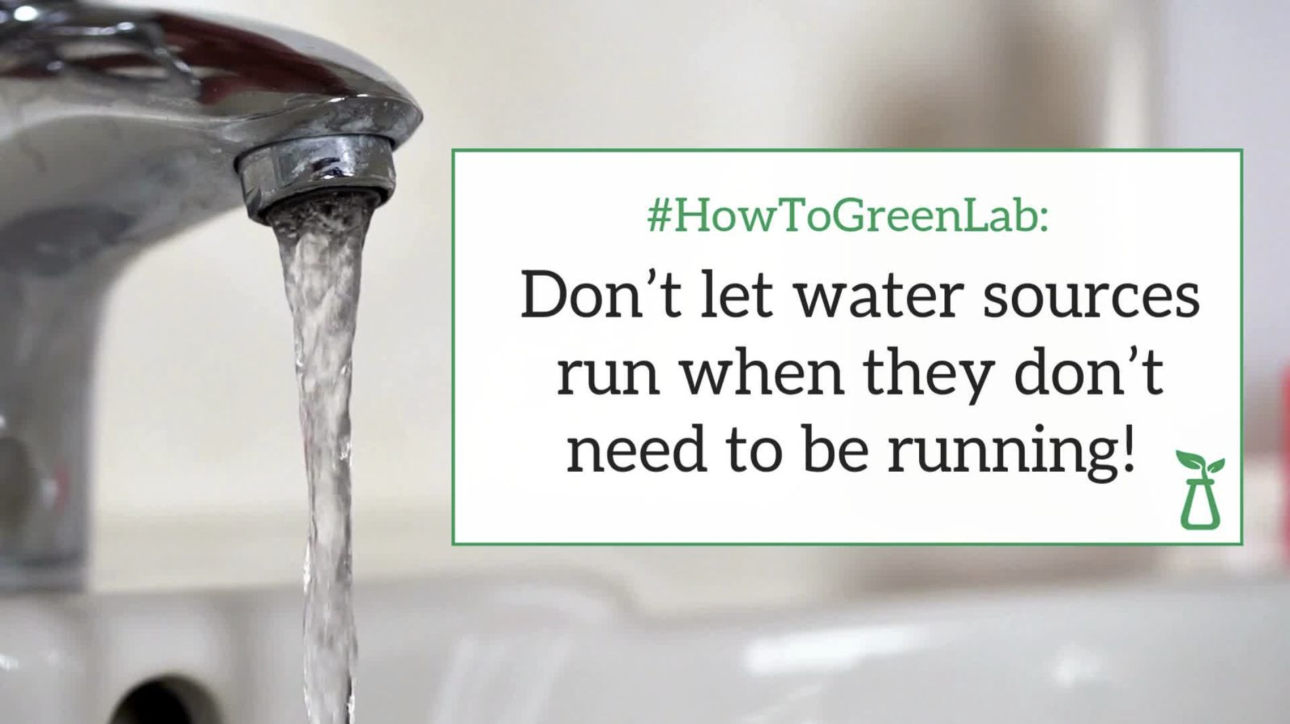
Looking for a simple way to keep sustainability top of mind in the lab? Try kicking off team meetings with a “Green Minute.”
Use this time to share a quick tip, spotlight a sustainable action someone took, or introduce a new eco-friendly practice. It’s a small habit that builds awareness, encourages conversation, and keeps momentum going, one minute at a time. Because sustainability isn’t a side task, it’s a shared mindset.

This month’s #HowToGreenLab is to provide clearly labeled, accessible bins for each waste stream, including recycling. This ensures materials are disposed of correctly. Proper waste sorting is essential for a sustainable lab.

Ever noticed that a particular product in your lab generates a significant amount of waste? Instead of accepting it as the norm, consider reaching out to your supplier. A quick conversation could reveal alternative products with less packaging, reusable options, or even take-back programs you didn’t know existed.
By communicating your concerns and sustainability goals, you’re not just reducing waste—you’re signaling to suppliers that demand for more sustainable solutions exists. Over time, these conversations can drive industry-wide changes, making lower-waste options more available to everyone.
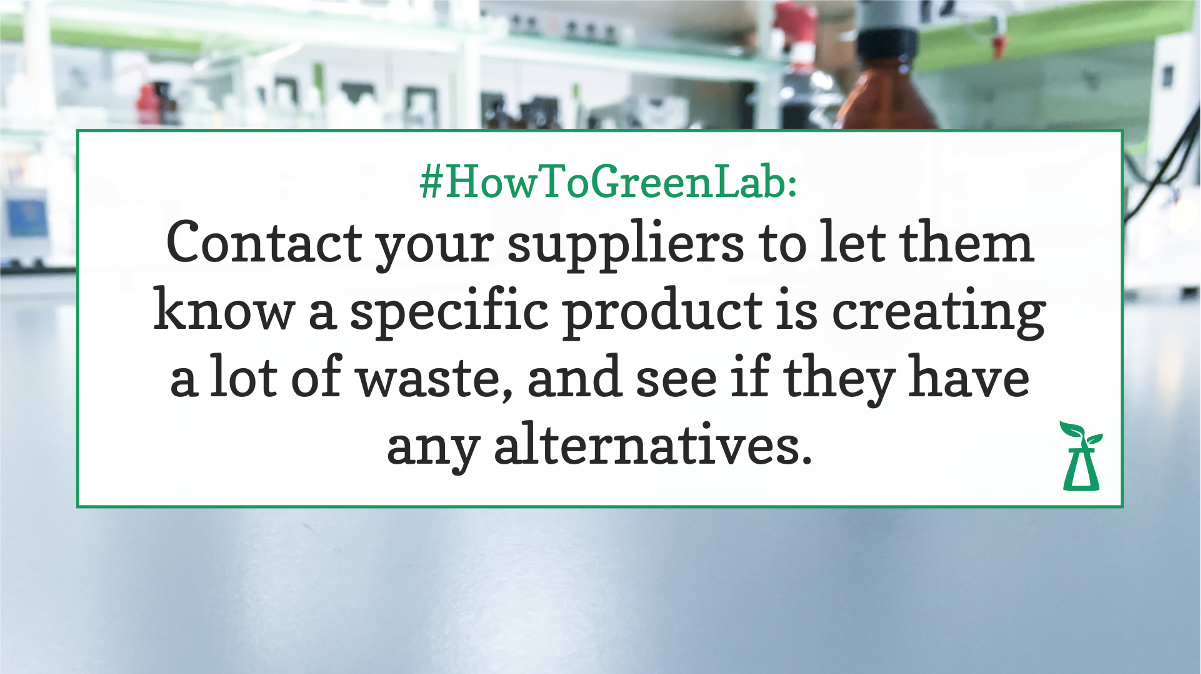
This month’s #HowToGreenLab is to place freezers on a scheduled defrost rotation to optimize efficiency. Freezers can accumulate ice buildup over time, which makes them work harder to maintain low temperatures. This excess ice can lead to higher energy consumption, longer operating times, and the risk of overworking the compressor. By implementing a scheduled defrosting routine, you can minimize ice buildup, ensuring that the freezer runs more efficiently.
If you’re wondering “How do I make my lab more sustainable?” Then sign up for the International Laboratory Freezer Challenge, a free, friendly competition that teaches you how to be more energy efficient with your lab’s cold storage!
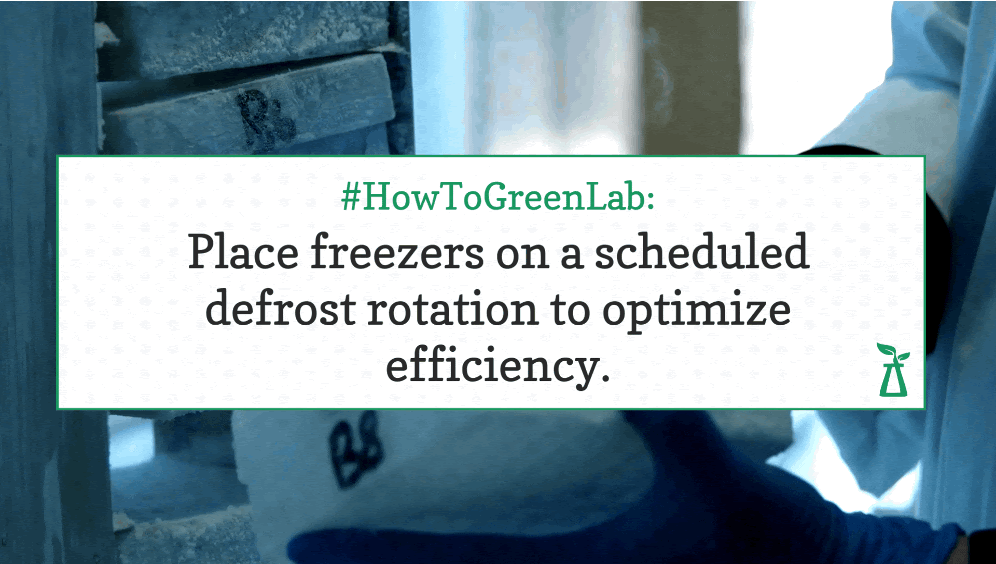
This month’s #HowToGreenLab tip is to be clear on capacity requirements and space when selecting an Ultra-Low Temperature (ULT) Freezer. Know exactly how much storage is needed and how much floor space is available within your lab to house ULT units. No matter how good your ULT freezer is, if it can’t fit in your lab or store all the necessary inventory, then it won’t be much help.
Additionally, keep in mind that many ULT freezers need a certain amount of clearance at the front and back of the unit to allow for adequate ventilation, which may catch some people off guard when planning how units fit into their lab space. Be sure to plan for ventilation requirements from the start.
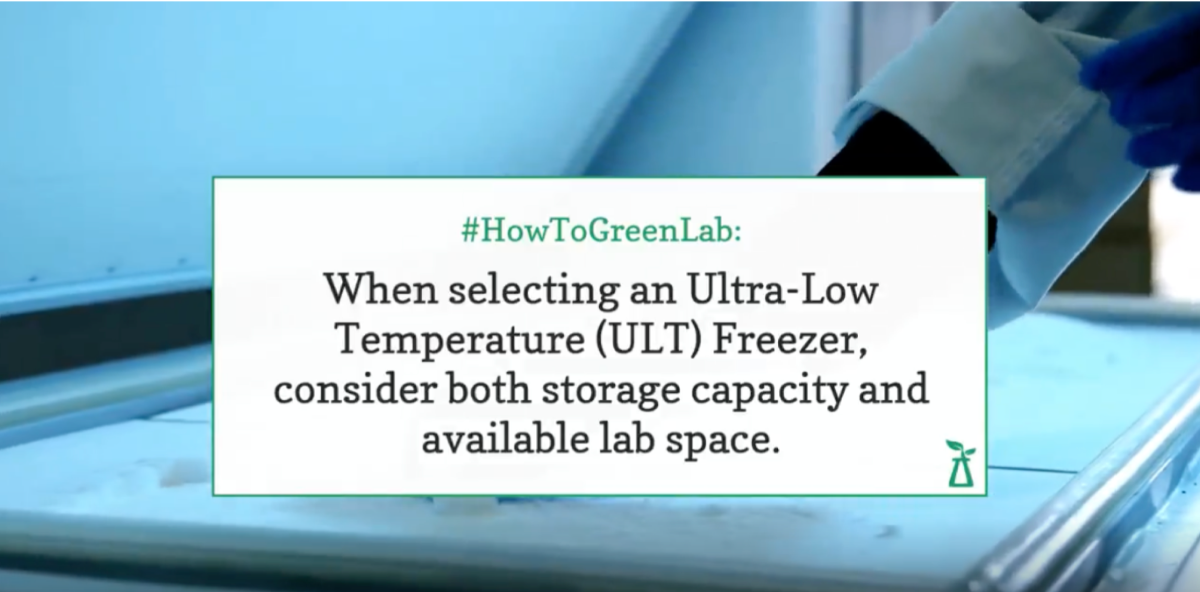
This month’s #HowToGreenLab tip is to label energy-intensive equipment. Help your lab save energy by labeling energy-intensive equipment with reminders to turn it off when not in use. Start by identifying equipment such as biosafety cabinets, centrifuges, and spectrometers that consume high amounts of energy.
Add simple, clear instructions like “Turn Off When Not in Use” or “Shut Down Overnight” directly on the equipment. To make it engaging, consider using creative designs or mascots to make the labels more memorable.
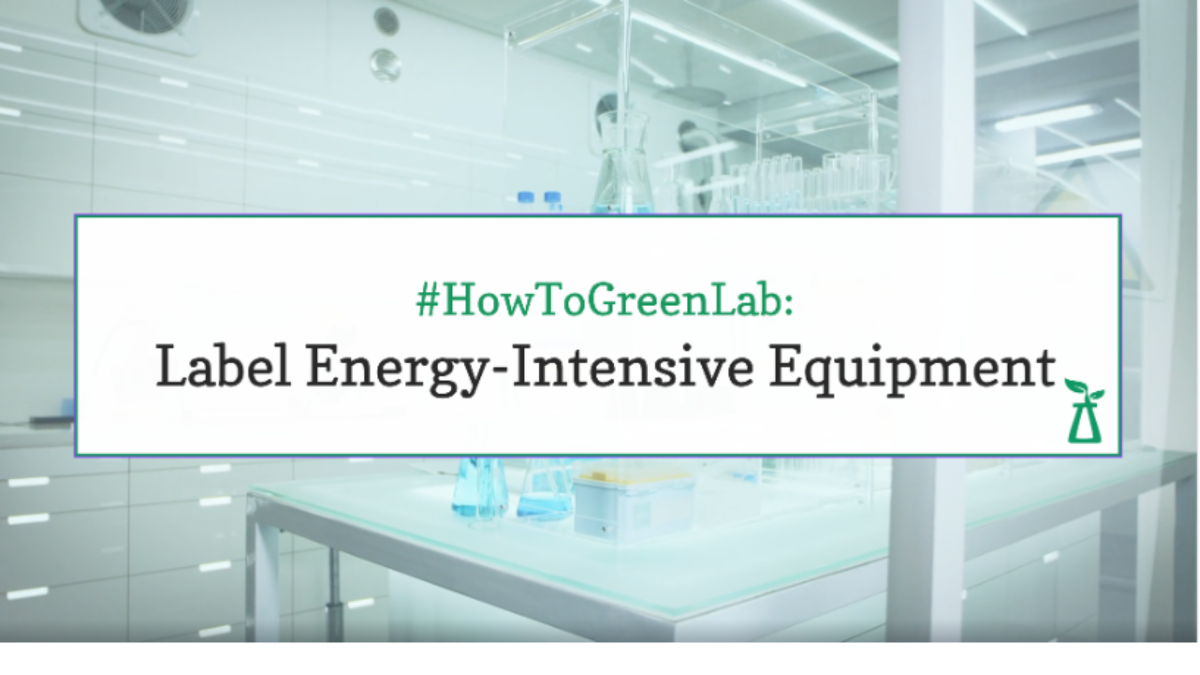
This month’s #HowToGreenLab is to share printers among colleagues and default to double-sided, black-and-white mode. While it may sound simple, this not only reduces paper waste but also contributes to a cleaner laboratory environment by minimizing clutter.
Every little bit helps to make your lab more sustainable!

This month’s #HowToGreenLab tip is to organize a sharing system among labs. Sharing equipment is an excellent opportunity to reduce the environmental impact of research. By sharing resources, labs can avoid unnecessary utility loads, reduce energy-intensive lab space to house duplicative instrumentation, and prevent the need for expanding ventilation and utilities for extra equipment. Not only does this save energy, but it also minimizes the production, transportation, and disposal of redundant tools. While sharing is often organized for high-cost or utility-heavy instruments, there’s untapped potential to expand these efforts for more everyday equipment, leading to greater efficiency in science.

This month’s #HowToGreenLab is to use digital reminders to help colleagues remember to engage in sustainable activities. For example, sending automated emails or calendar notifications to remind lab members to turn off equipment overnight.

This month’s #HowToGreenLab tip is reuse packaging like coolers and gel packs when shipping samples to your collaborators. Labs receive a lot of packaging items, and finding alternative ways to reuse these items is a great way to cut back on waste.

This month’s #HowToGreenLab is to shut down biosafety cabinets (BSCs) when not in use.
Did you know that BSCs can consume 15 kWh/day – about half as much as a house? Turning this equipment off when it’s not in use, or on nights and weekends, can have a big impact on energy usage.
Ready to become an energy expert? Start our AP Program module on energy efficiency today by clicking here.

This month’s #HowToGreenLab tip is to optimize your lab’s cold storage with racking systems. Proper inventory and sample management can be challenging, but using racks helps maximize vertical space, improving storage efficiency and reducing the need for additional freezers. This low-cost solution is essential for making the most of your space while ensuring proper storage conditions.
Interested in more tips on how to become more energy efficient with your lab’s cold storage? Check out the #FreezerChallenge, a fun, FREE competition that will teach your lab how to improve sample accessibility, reduce risk, and save costs for your institutions here.

This month’s #HowToGreenLab is to form a “Green Team” at your organization! Formalizing a group who can explore ways in which your lab’s carbon footprint can be reduced is a great first step in towards sustainability.
Have you formed a green or sustainability team at your organization? Share your experience with us in the comments below.
Learn how to empower and inspire scientists to successfully modify long held habits in the lab through our AP Course Engagement Module here.

This month’s #HowToGreenLab tip is to implement smart sensors for equipment monitoring. Consider implementing smart sensors on lab equipment for real-time monitoring of temperature, humidity, energy consumption, and equipment usage. This real-time information helps in understanding the
operational conditions of lab equipment and identifying opportunities for energy optimization.
Thanks to Renovo Solutions Life Sciences for this month’s tip! Learn more about saving energy by downloading their recent white paper, “10 Ways to Increase Energy Efficiency,” here.

This month’s #HowToGreenLab tip is to make sustainability in the lab a social norm! People pay attention to what their peers do, especially friends, family, coworkers, and neighbors. Create norming your sustainability efforts in the lab and within your building by advertising what you’re doing to be more sustainable. And lead by example!

This month’s #HowToGreenLab tip is to use and maintain a chemical inventory. The easiest way to avoid over-purchasing chemicals, and to reduce the amount of chemical waste in your lab, is to keep an up-to-date chemical inventory log of all of the chemicals in the lab.

This month’s #HowToGreenLab is to implement Freezer Fridays! Organize a collaborative effort to clear out freezers with the entire lab group over a few weeks. Implementing “Freezer Fridays” for a month can result in improved order, enhanced sample accessibility, and a potential 30% increase in freezer space.
Learn more cold storage sustainability tips by joining the 2024 Freezer Challenge here.

This month’s #HowToGreenLab tip is to conduct a waste audit. When it comes to lab waste, one of the most important things to understand is exactly what you’re discarding. To do that, we recommend conducting a waste audit. Start by taking note of what it is that you throw away – not just in your waste bin, but in your recycle bins and solvent waste containers, as well. If you’re able to get an understanding of what you’re throwing away, and how you’re throwing it away, it will help prioritize what you can change.

This month’s #HowToGreenLap tip is to check for leaky faucets. It may sound simple, but leaky faucets that drip once per second can waste 3,000 gallons of water per year. According to the US EPA, that’s enough water for more than 180 showers!
Check for leaks anywhere you have a line that constantly maintains water. You can find leaks on autoclaves, ice machines, and water cooled equipment. Once found, promptly report leaks, and make it a common practice to keep an eye out.
Learn more ways to save water by taking our AP Program course on water. This newly released module discusses the drivers of water consumption in labs and provides practical knowledge and strategies to improve the water efficiency of your lab.

This month’s #HowToGreenLab tip is to only use purified water when needed.
In order to make purified water, you have to clean and filter it in a process that is not 100% efficient. For instance, it takes about 3 liters of water to make 1 liter of deionized water. If you’re using purified water systems, make sure that you’re only using purified water when needed.

This month’s #HowToGreenLab is to put autoclaves in standby mode when not in use and only run them when full.
Autoclaves consume 84 kWh per day. Specifically, large, steam-jacketed or medical grade autoclaves are massive energy consumers. Ensure you’re putting them into an energy conserving or stand-by mode when not in use, and only run them when they are full.
Stay tuned for My Green Lab’s AP Program energy module to learn more about how you can reduce energy in the lab – launching soon!

This month’s #HowToGreenLab is to reduce your use! The best way to impact waste is to reduce its production from the start. Here are some tips to reduce you lab’s contribution to the landfill:
- Once upon a time scientists used glassware instead of plasticware. Determine if there are any single-use plastics used by your lab that could be swapped for glass and reused indefinitely, reducing your lab’s need to purchase single-use materials.
- Share resources. If you have something you’re not using, offer it to a colleague. This includes equipment, reagents, and consumable supplies. Be sure to do so in accordance with your organization’s Environmental Health & Safety guidelines.
- Consolidate orders, and order what you need (bulk purchases are only a good deal if you need that much). If you only require a small amount, consider asking for a sample instead.
- Purchase from vendors that have sought to reduce their packaging. Many vendors have made conscious decisions to use smaller boxes and materials that are more readily recyclable in shipments.

This month’s #HowToGreenLab tip is to rethink the way you light your lab. There are a variety of options to reduce the amount of light that is used in your lab, including:
- LED lighting: An energy-efficient alternative to traditional lighting that can significantly reduce energy usage in a lab.
- Label switches: Multiple light switches can be confusing and can lead to improper use. If more than one light switch is in a panel, mark the switches to indicate their function.
- Task Lamps: If you’re working at your desk, there is no need for all of the lights to be on in the lab. Instead of overhead lights, consider task lamps.

This month’s #HowToGreenLab tip is to purchase energy efficient equipment! Freezers, refrigerators, ice machines, vortexes, drying ovens, and water baths are just a few examples of appliances that can be ENERGY STAR labeled, EU Energy Labeled, or labeled through the relevant energy efficiency program for your region. These energy efficiency programs are great resources for making smart, sustainable purchases.
Additionally, the ACT Label database has a wide variety of equipment and products that can help you consider the environmental impact of lab products and make informed purchases. Check it out: https://actdatabase.mygreenlab.org/

This month’s #HowToGreenLab tip is to use your voice to bring awareness to lab sustainability and help drive greener practices.
“Scientists don’t always realize the power of their voices within the scientific sector – your purchasing decisions matter; where you choose to travel for conferences (or how) matters; your sustainable actions at the lab bench matter; what you discuss with suppliers and sales reps matters,” says Senior Programs Manager Christina Greever. “Collectively, the voice of scientists could be enormous, and the lab sustainability movement has been working for years to bring those voices together into a loud chorus that will change how science is done.”

This month’s #HowToGreenLab tip is to practice good inventory management.
Good inventory management practices can lead to significant cost savings for the lab (by avoiding duplicate purchases), and can significantly reduce the amount of waste produced by the lab (with fewer out-of-date bottles discarded).

This month’s green lab tip is to turn to tech! When appropriate and possible, consider using computer simulations to reduce the amount of chemicals and reagents used in your experiments.

This month’s #HowToGreenLab Tip: Share equipment among labs!
Equipment sharing has a similar energy saving impact as turning off equipment when it’s not in use. “Sharing” equipment can be useful even for labs that are using their own equipment. Here’s where scheduling comes in handy. Figuring out how often your lab is using equipment can allow you to optimize the time that it’s in use. Say your lab has two HPLCs that are only used, on average, 40% of the time. Through simple scheduling, you can consolidate use on the first and unplug the second. You’ll save energy and have the second HPLC ready to bring back online if the first one breaks.
Shared resource or instrumentation facilities are particularly useful for universities, where bigger pieces of high energy consuming equipment are in a shared lab and everyone has access, reducing the need for multiple labs to have to buy their own.

Did you know that Preventative maintenance can help keep cold storage running efficiently? Here are a few tips to properly maintain cold storage
- Clean heat exchange coils and clean or replace filters help to make sure cold storage can exchange heat efficiently. This will save 10% of energy.
- Ensure you’re defrosting regularly so that space is used efficiently and so you don’t get ice build up (which can make it so the door doesn’t shut properly – a common issue in laboratories).
- Check door seals. Cracks and tears can let hot air in and make the compressor run more to maintain low temperatures.

Did you know that low-flow aerators can help reduce faucet flow from 4.0 gallons/minute to <1.5 gallons/minute? Low-flow aerators simply screw onto the end of faucets and reduce flow without changing water pressure. It’s an easy and cheap option that will significantly reduce water usage. Your organization may even have aerators on hand and can help install them. All you have to do is ask! #HowToGreenLab
In a case study conducted at UC San Diego in 2017-2018, aerators installed in labs across the campus saved a whopping 926,000 gallons of potable water per year.

Your lab undoubtably receives a lot of deliveries, which can include an excessive amount of ice packs within the packaging. A great way to repurpose these ice packs is to connect with local sports teams or university gyms who can reuse ice packs for sports injuries.

My Green Lab offers a suite of leading-edge programs to engage everyone from students
and researchers, to laboratories, major institutions, and corporations in an effort to fundamentally and permanently improve the environmental performance of scientific research.
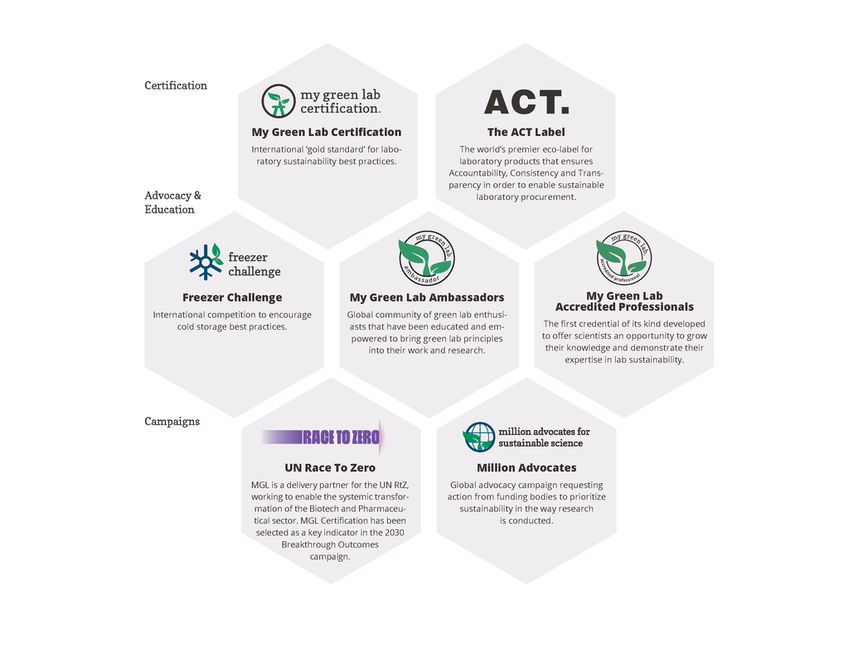
The My Green Lab ACT Label database is a quick and easy way to compare lab consumables,
equipment, and reagents. Utilizing our database makes it easy for you to learn about the environmental impact of products, and helps you choose more sustainable products.

Steam Jacketed autoclaves use a lot of water to sterilize equipment, reagents, and hazardous waste in labs. By retrofitting autoclaves with water-saving devices, you can cut back water usage by 75-90%. That’s huge! Add this effective water-saving action to the top of your to-do list.
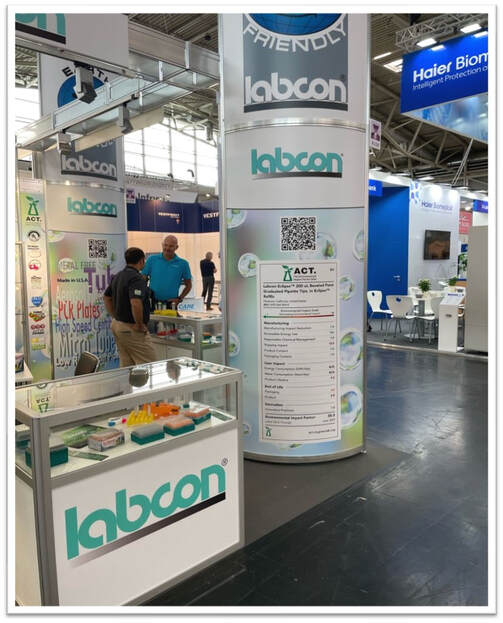
While it may sound simple, turning off the lights at the end of the day can make a difference!
Lighting makes up around 15% of energy in the lab. Simply turning off the lights when you leave the lab or support rooms can have a significant impact.
Turning off the lights during the day when ambient light is sufficient can even further reduce energy consumption. A small LED task light can provide additional illumination if needed and uses much less energy than overhead lights.

Scientific products use a lot of packaging, from boxes, to instructions, to double wrapping for sterile products, to shipping boxes with padding. Here are a few things to consider when addressing packaging waste:
- Consolidate what you’re buying from different suppliers into one, or consolidate the number of times you place an order from a particular supplier.
- Designate an employee to handle orders, whether it’s one person who places all orders with all suppliers, or a designated person for each supplier.
- If applicable, consolidate orders with neighboring labs.
- If you have the space to store extra consumables, buy in bulk to reduce shipments.
- Right-size your purchases. For example, if you only need 50ml of a reagent for a set of experiments you’re planning, rather than buying a 1 liter bottle, buy the 100ml bottle. The bottle is smaller, and you’ll end up with less waste if you don’t use all of that chemical.
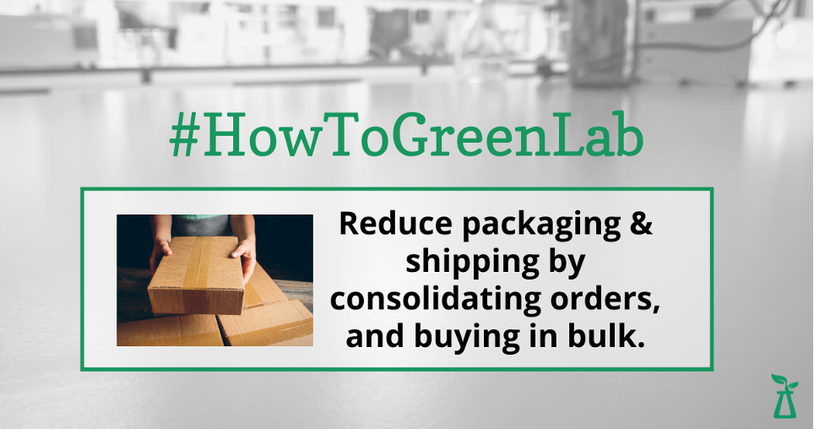
Many companies have recognized the importance of helping labs divert their waste. Take-back programs can be free or relatively low cost, and are a great way to reduce the amount of waste your lab generates.
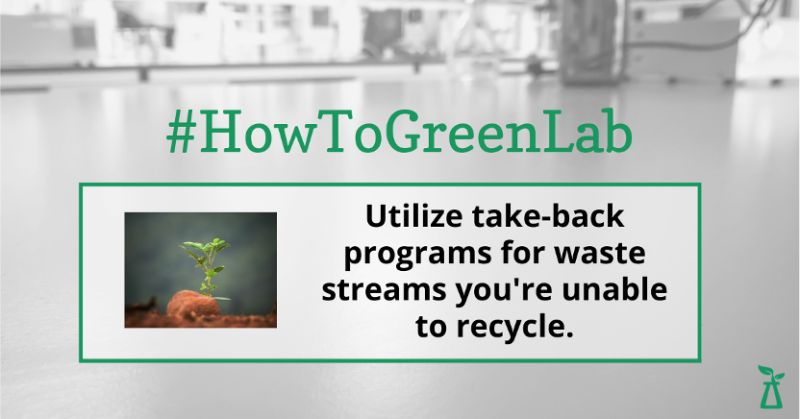
Chilling up your ultra-low freezer from -80 to -70 has two major benefits: it can reduce energy consumption by 30-40%, and in doing so it can prolong the life of your freezer. This means less down time and less chance that your samples will be compromised.
To learn how to be more energy efficient with your lab’s cold storage, join the #FreezerChallenge!

The best way to impact waste is to reduce its production from the start. This month’s #HowToGreenLab tip is to reduce your lab’s contribution to the landfill. This can be achieved in a variety of ways, including:
-Purchasing items that have long lifetimes, or that eliminate waste streams.
-Sharing resources including equipment, reagents/chemicals, and consumables.
-Consolidating orders, and order only what you need.
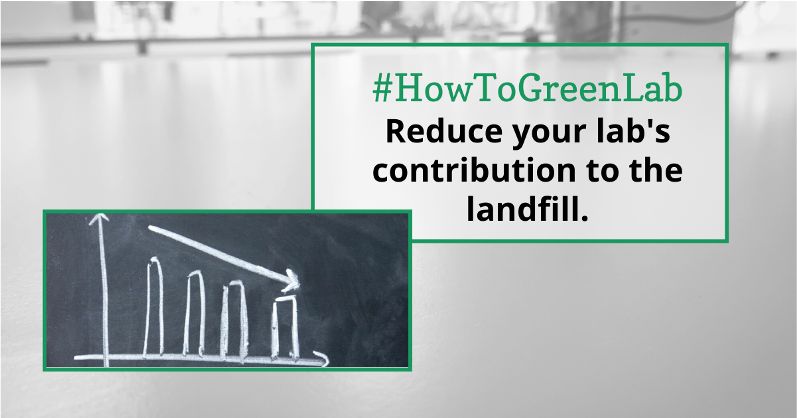
A great way to reduce water consumption in the laboratory is to eliminate single pass cooling – a wasteful process that can also be a safety hazard. Learn how to eliminate single-pass cooling by trying one of these alternatives here.
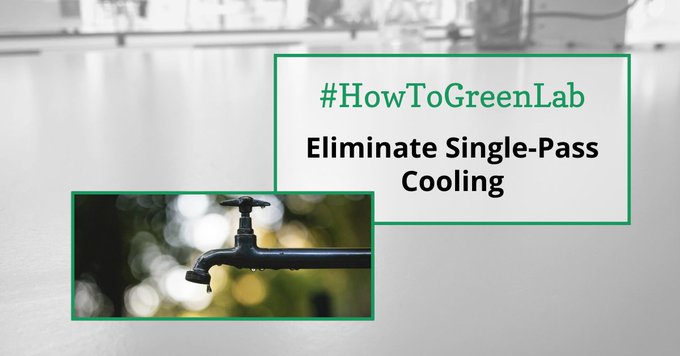
Through this month’s #HowToGreenLab, we encourage you to share your knowledge with those around you. When motivated by energetic and passionate individuals, a confident community forms—one that works towards and achieves collective goals. Harness the power of collective action!
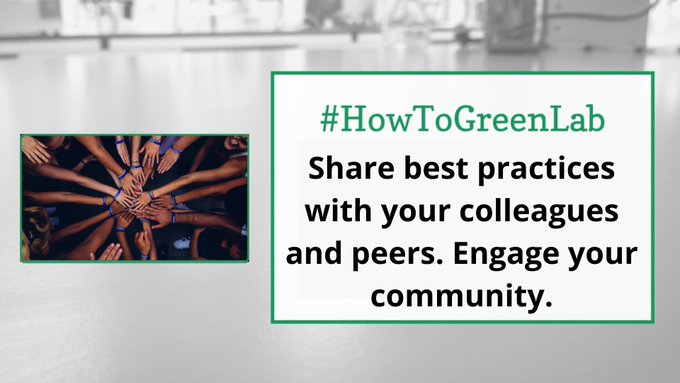
This month’s #HowToGreenLab tip is about chemical inventories—a critical component of sustainable labs. Managing lab chemicals ensures that you don’t duplicate chemical purchases or possess expired chemicals. Inventories can be used across departments, enabling chemical sharing.
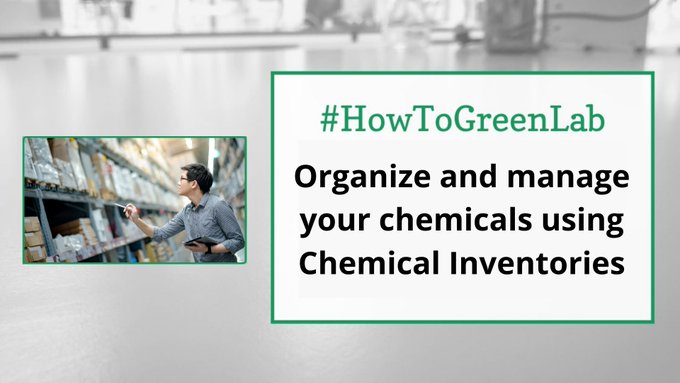
Did you know? Running screensavers requires the use of computer processing power & memory, & as a result uses energy. Our #HowToGreenLab tip this month is to turn off lab computers & monitors completely when not in use. Though it may seem simple, every bit of energy saved counts!
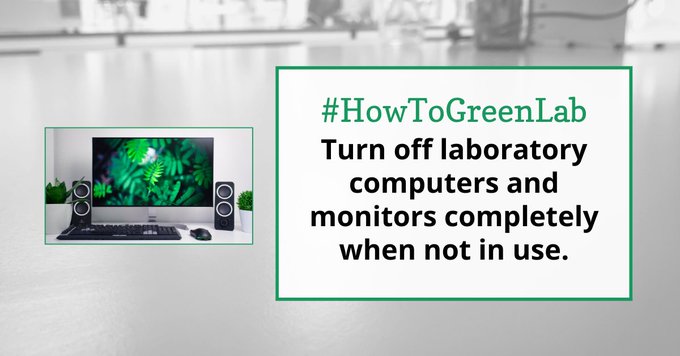
This month’s #HowToGreenLab is about take-back programs! Take-back programs are a free or relatively low cost option offering a great way to reduce the amount of waste your lab generates. Learn more here.
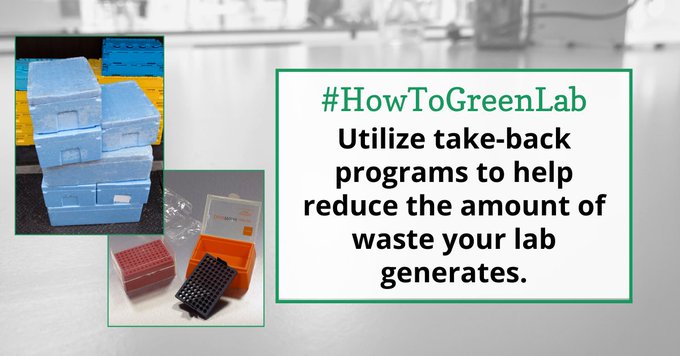
Welcome to our new series, #HowToGreenLab! We’ll be sharing useful tips and hacks to help you green your lab. Our first tip is all about how to save energy, which you can do by remembering to shut fume hood sashes when work in the hood is complete. A single chemical fume hood can use as much energy as 3.5 households EVERY DAY. By lowering the sash in certain types of fume hoods including variable air volume (VAV) fume hoods, you can save up to 40% of energy. Remember to “be good in the hood!”

